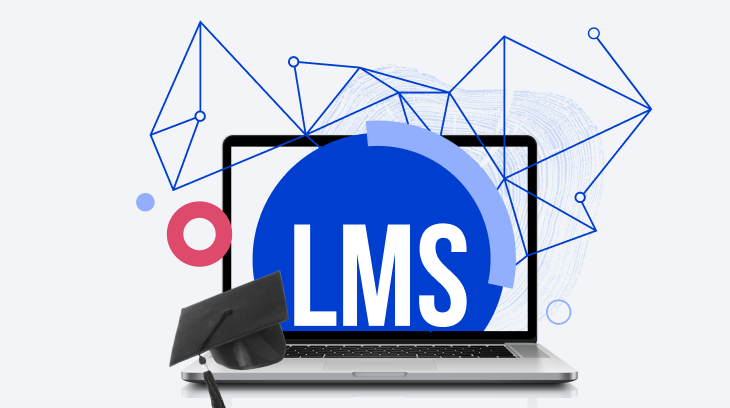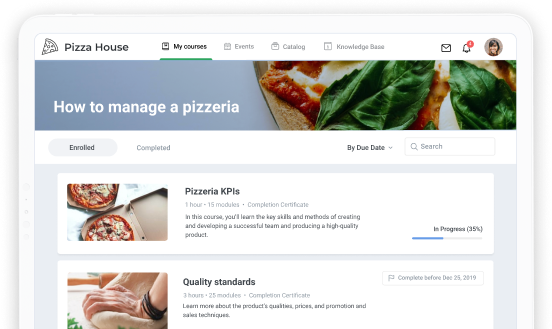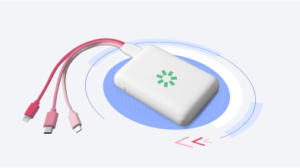What Is an LMS? Definition, Features, and Use Cases

Schools and universities, coffee shops, and billion-dollar enterprises – today almost every organization either already has or is about to get a learning management system (LMS). If you’ve never heard of LMSs, you might be wondering what they are, why organizations use them, how your company can benefit from one, and more.
After reading this article, you’ll know everything you need to know. So, let’s begin.
What Is an LMS?
An LMS is a platform for digital learning. Its key features can be found in the abbreviation.
L — Learning. This type of software is designed for convenient learning anytime and anywhere. Learners can access an in-house knowledge base, take assessments, and complete practical assignments.
M — Management. Unlike file sharing services, a learning platform is not just a heap of files. It enables admins to manage user data and enrollments in courses, organize content into comprehensive training programs, and control how learners progress in training.
S — System. It’s a computer system, to be precise, that processes various types of data and puts them in order. It collects statistics, runs reports, and automates grading, thus streamlining the entire training process.
How Does an LMS Work?
An LMS is like your own online university, where you can upload, store, and create online courses for learners to access on PCs, laptops, tablets, or smartphones, in a browser, or via a mobile app.
From your courses, ebooks, and videos, you can build an entire corporate knowledge base or establish specialized learning paths for given positions or employee groups, like new hires or franchisees.
Watch this video to see how an LMS works and how it can help your business grow.
Who Uses an LMS?
The size and scope of organizations that leverage LMSs is pretty broad. It can be a large global enterprise with thousands of learners or a startup that uses an LMS for small businesses. And of course, there can be nonprofit organizations, government agencies, and educational institutions that train a variety of audiences.
What Are the Benefits of an LMS?
There are a lot of obvious advantages of using an LMS both for businesses and learners:
| For businesses | For learners |
| Reduce training costs | Access learning content anytime and in any location |
| Cut down the time needed for employee onboarding | Increased engagement and a consistent welcome experience |
| Stay on top of compliance training and keep everyone up to date with the latest regulations | Higher compliance and workplace safety levels |
| Deliver quality product training at scale | Increased confidence of sales associates and customer support specialists |
| Maintain a unified approach to marketing, sales, and customer service through channel partner training | Streamlined communication between partners and affiliates |
| Educate end users on product qualities or features with customer training | Happy customers |
| Create individual learning plans at each stage of the employee life cycle | Improved work performance and opportunities for promotion |
| Measure training effectiveness | Boosted knowledge retention |
You can see that these benefits of a learning management system create a variety of training scenarios or situations where you can use it. Feel free to see more cases and learn exactly how corporate LMSs can drive your business success.
Types of LMSs
Now it’s time to move to a more technical part and figure out what types of learning platforms exist and how they differ. Here’s a description of different types of LMSs:

Corporate vs. Academic LMS
Both corporate and academic LMSs provide access to course materials online and automate different aspects of training processes, but they have some differences.
Also read: → Best Corporate eLearning Platforms
Learning goals
Academic learning is aimed at producing good students who have a profound knowledge of subjects and strive to learn more. Here, theoretical knowledge is the end goal. In turn, corporate training focuses on practical application, and one of its main objectives is ROI.
Course timeline
For workforce training, time limits are shorter, so a corporate training platform must be flexible to fit all time frames and business needs. Semesters, trimesters, and quarters — these are the time frames for educational institutions. For them, such scheduling units as holidays, exam times, and periods are needed.
Certifications vs. grades
Corporate software usually offers the capability of tracking and completion in the form of certifications. The academic software typically tracks learners’ progress through its grading system. It provides grade books for monitoring attendance and assignment results, as well as keeping other information on each student in the roster.
Tools for social learning
Other functionalities that an academic learning platform usually provides are capabilities for creating student groups for class projects and breakout sessions, discussion boards, and a built-in web-conferencing tool.
Content updates
Educational LMSs don’t need to be updated regularly because the content is mostly based on the sciences and humanities. In contrast, a corporate LMS should have the ability to quickly and easily update courses to match changing market needs.

Free vs. Commercial
When choosing between a free, open-source system and a commercial platform, you need to know that not all open-source LMSs are, in fact, actually free. There may be no license fee, but you may need to set up a server and a hosting architecture, customize certain features and branding, and regularly upgrade your system – so you need technical talent in your team to succeed.
The ideal solution for users without an IT background is commercial LMS software. It’s typically much easier to deploy and use, offers tech support services, and doesn’t incur additional costs.

SaaS / Cloud LMS vs Locally hosted LMS
You can store all the data on your company’s own servers, thus hosting the system yourself, or you can select a SaaS LMS platform, and leave it to your vendor to deal with server load, backups, and security. A SaaS platform is the best match if you don’t have IT staff in place and want to focus on creating learning content.
Some companies avoid cloud-based learning management systems because of data security concerns. They believe that their information that is stored on a remote server may be compromised. However, there are different ways to safeguard your data. For instance, ensure that the LMS vendor has effective encryption protocols and will back up your information.

LMS vs LCMS
If you’re going to build courses in-house, you can choose between two alternatives: either buy an LCMS with course-creating functionalities or purchase an LMS and an authoring tool separately.
However, here you can face two problems:
- Built-in course editors usually have serious functional limitations.
- Not all LMSs and authoring tools are fully compatible.
If you want to avoid compatibility problems and create beautiful interactive courses, choose an LMS with a bundled authoring tool, like iSpring Learn LMS and iSpring Suite. This integration allows you to create professional-looking e-courses, easily upload them to the platform, and enjoy advanced reporting capabilities.
LMS Standards
Selecting a unified standard for both eLearning authoring tools and LMSs means that information will be successfully shared between them.
Here are the five major LMS standards that predetermine the compatibility between an LMS and an authoring tool:
- AICC. The oldest technical standard lets a course transfer information in HTTP format. It is no longer evolving, but there are some LMSs and authoring tools that are AICC compliant.
- SCORM. This is the standard that is recognized by almost every learning platform and enables content to interact with the system to track user progress and manipulate the course structure to a great degree. There are currently four different versions of this standard: SCORM 1.0, 1.1, 1.2, and 2004.
- xAPI, or Tin Can. It is a nextgen version of SCORM that can exchange data with an extended number of software, like talent management systems or mobile apps, and tracks most learning activities, including experiential learning and simulations.
- LMS LTI. This standard is especially popular in higher education, as it enables content creators to build courses within their own tools to share them with learners on different platforms.
- Cmi5. It is the newest standard that provides all the capabilities of SCORM and xAPI together. Thus, cmi5 content can be viewed on mobile devices, even offline, and you can get detailed statistics on any format of content, including PDFs, videos, and games.
Now, let’s proceed to the next level of understanding of what an LMS is and explore it in terms of common features, tracking options, and pricing.
LMS Features
There’s no universal agreement on the full feature set of a standard platform, but you can think of the first three items on the list below as basic LMS features and the rest as advanced.
- User management. It allows you to add and edit users, ad their roles, and combine learners into groups and organizations.
- Course management. It delivers learning materials to the learners who need them.
- Progress tracking. An LMS assesses learner performance in real time.
- Content creation. It can be a built-in editor that allows you to create page-like courses.
- ILT Classroom. It can provide extended support for classroom-based initiatives (e.g., managing schedules, monitoring attendance, etc.).
- Mobile learning. Some LMSs have native mobile apps for viewing courses even when offline.
- Social learning. It can serve as social tools that allow users to publish articles, discuss colleagues’ posts, and like and share content.
- White labeling and customization. Your platform can use branding and help maintain brand consistency within the learning experience.
- Gamification. Points, awards, ratings, and badges can increase learners’ retention, engagement, and motivation to study harder.
- Certification. It can issue certificates of completion for regular professional certifications.
For more details about must-have and optional features, see this article about LMS requirements.
LMS Tracking
A learning management system makes tracking training progress entirely possible with detailed LMS reports. The essential training metrics and reports typically include:
Learner progress and completion rates
These metrics show how your individual learners are faring, and you can and track how far they’ve come and see if they’ve completed a course successfully.
Online learning assessment results
This metric helps you monitor skill and knowledge gaps as learners complete training courses, and see if they need more information on those topics.
Course overview
Course overview reports show you what percentage of learners completed a course, how much time they needed to view each activity, and their average score.
Satisfaction rates
An LMS typically allows you to evaluate learner satisfaction by conducting user surveys, polls, and questionnaires.
LMS Pricing
When looking for a learning management system, you can’t avoid the financial aspect. To choose the best option for your business, see what pricing models exist and how they work.
| Pay per active user | Pay per learner | Pay as you go | License Fee / Subscription |
| You pay for each person who actively uses the LMS during each billing cycle. | You’re charged for a fixed number of learners, regardless of whether they are active or not. | You pay only for what you use — for instance, users and the courses they take. | You pay a monthly or annual license fee for the LMS. The price typically varies, depending on the features included. |
To know which method of payment suits you best, see a full comparison table of the most common pricing models with examples of LMSs that offer them.
How to Choose an LMS
If you perform an online search for “LMS,” you’ll get millions of results, many of which will be vendors promoting their products. It’s not easy to choose the best one for your business when the options are so numerous. If you find yourself in a situation like this, the free white paper “How to Choose a Learning Management System” will come in especially handy.
This free white paper provides training managers and L&D pros with all the essentials to make an informed decision and match any kinds of requirements that the higher management and IT department might impose. Check it out and equip yourself with the knowledge of the way to choose an LMS that will really bring you ROI of training and professional development.
How to Organize Learning with an LMS
Let’s take iSpring Learn LMS as an example to see how to organize training with an LMS.
iSpring Learn is a cloud-based service, so all that’s required is an Internet connection and an email to register an account.
Step 1: Upload courses
To start training, you need to add materials to the LMS. The process of uploading content to iSpring Learn is similar to working with file-sharing services like Google Drive or Dropbox. Click the “Upload File” button and select the files from your computer.

The LMS recognizes ordinary PPT presentations, audio and video files, and text documents, as well as special SCORM courses. You can always combine them into a Learning track for a consistent flow, even with the most complex subjects, and set the required evaluation criteria.
Step 2: Add users
One of the most useful features is different user roles. In any LMS, there are 3 main user types:
- A user or a learner who takes the assigned courses and studies the available materials.
- An author who can manage training content: add and remove courses, and assign courses to learners.
- An administrator who can add and remove users, gather them into groups, and assign roles.
In a worthwhile LMS, administrators are freed from tedious work like adding users to the system manually, as most of the processes are automated. For example, you can invite learners by email or import a list from an XLSX file. You also can divide learners into groups, like “newcomers” and “pros,” or organize them according to their work areas: sales, security, or production, for instance.

Step 3: Deliver knowledge
After your content is uploaded and user roles are assigned, you’re ready to present courses to your learners in the most accessible manner. You can grant access to all users or invite specific individuals by email. Then, learners can take courses on multiple devices, including tablets and smartphones. With the free mobile app by iSpring Learn, they can study when and where they want: at home, in a café at lunchtime, while commuting, or even when offline.

Step 4: Evaluate the results
The ability to measure the effectiveness of training is one of the main reasons why more and more companies are getting started with LMSs. You can track the progress of as many learners as you have in real time and see detailed statistics on time spent, attempts made, and more.

Is There a Way to Try out an LMS?
If you want to find out if training with an LMS is right for you and your company, take advantage of the free 30-day trial of iSpring Learn.
Launching training will take no more than a day. You don’t need to ask technicians to configure the system — it’s all set up for effective training. To see how easy things can be with iSpring Learn, you can book a free live demo. Don’t miss this chance to see iSpring Learn in action!











